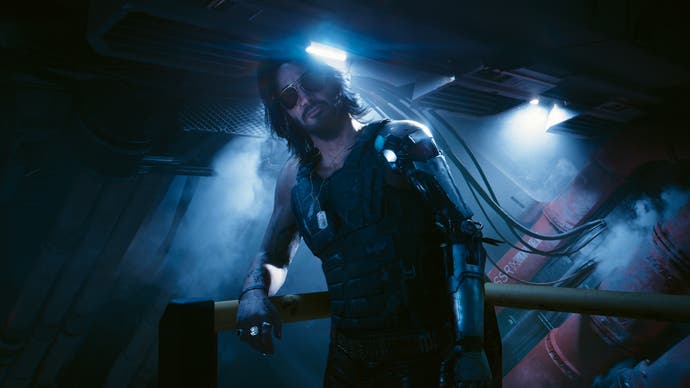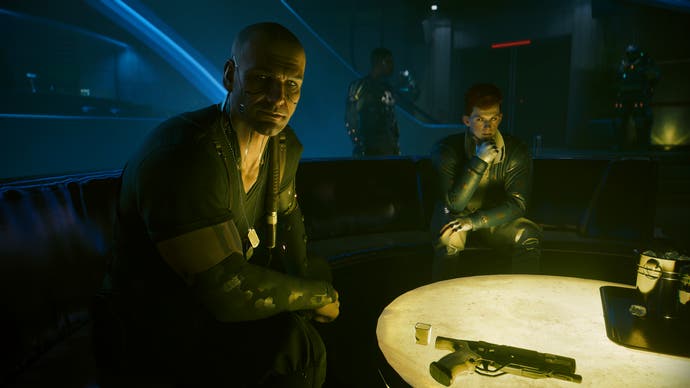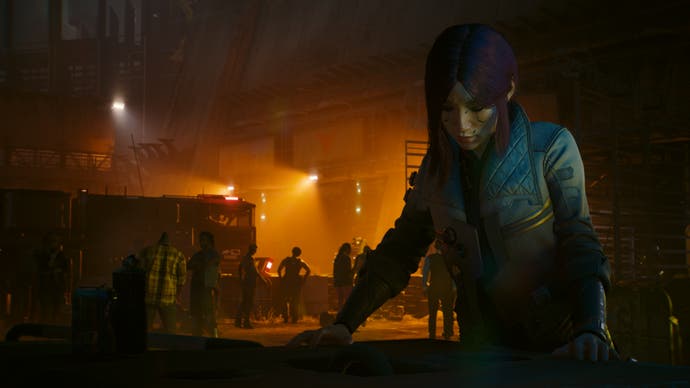Cyberpunk: Phantom Liberty adds new Edgerunners-inspired Cyberware limit
"You can play with the risk-reward of going too far..."
When you think about it, a spy thriller is a perfect fit for CD Projekt Red's Cyberpunk 2077. The original game was, if nothing else, a game swimming in uncertainty and conspiracy. It's riddled with spies and corporate espionage, duplicitous side characters with agendas of their own. Its first act ends in a dramatic heist. And in many ways, you don't know what consequences your choices might create.
CD Projekt unveiled its Phantom Liberty DLC with a typically bombastic trailer today at the Xbox showcase, but we've also seen it behind closed doors out in Los Angeles - a good chunk of it, in fact - as we played through about an hour of the expansion and spoke to game director Gabriel Amatangelo and lead environment artist Kacper Niepokólczycki about what you can expect.
Our impressions? Compared to the explosiveness of the base game's original unveiling, and its trailer today, Phantom Liberty was a little more muted.
Our demo opened with a stroll through the underbelly of Dogtown, Phantom Liberty's big new area, accompanied by a new character called So Mi - or 'Songbird' to V - who you've formed a bond with because, we're told, Songbird might have a cure for your John Silverhand-induced condition. We practically sprinted through it to get to the end of the narrative portion of what we could play here, but Dogtwon gives off the impression that it's pretty vast. It's based down in the Pacifica corner of the map. Director Amatangelo wouldn't be moved on what we can expect in terms of Phantom Liberty's length in raw hours, but described the DLC overall as "big".
"It's big. It's a big expansion. It's a healthy expansion. We're not gonna throw some specific numbers down, but because you know, people play in different ways, but we've got a lot of content, a lot of side quests. We've got a new layer to how the overall world works, which is very difficult to measure because it's a lot of dynamic activities all over the place."
One example given was a pillar of red smoke, coming up from above some buildings in the distance as we emerged out into the open world from a more linear part of a mission - go investigate and a side quest will open up. Others included the added depth to handlers and how they play into the story. Mr Hands, for instance, will return and have a major part to play in how the open world develops.
Here's how the mission itself unfolds: after emerging from the black market you head up to the roof of a stadium with Songbird and, with little setup, watch Space Force One, President Rosalind Myers' personal space-plane, get downed by missiles. Your mission? Save the President. You sprint to the crash site, take out a mix of enemies already pouring over the wreckage (and fighting with the President's sort-of-robotic guard), and meet her face to face.




Next up, find a safe place to hang out, use your scanner to find a battery for a basic generator, and then get some proper help. Enter Mr. Idris Elba, in the role of Solomon Reed, master spy. You'll have to track him down by finding a way into the building Madame President told you about - Cyberpunk's typical "three ways" method comes back here, as you can smash the door in, hack it or scan your surroundings until you find a route that takes you up to a generator that you can pull apart.
Inside it's another game of scan-to-progress, until you find a phone playfully hidden behind a movable storage cabinet and dial Reed's secret number. There is, for Cyberpunk at least, a tiny hint of levity to all of this - a bit of barely detectable campness - and then Reed himself is…surprisingly likeable?
I was curious about this - Pawel Sasko, Cyberpunk 2077's lead quest designer, had recently mentioned the studio had to make Keanu Reeves' Johnny Silverhand a "real asshole" in order to account for his inherent charms - but Amatangelo said it was a little more complex than that.




"We kept the narrative in the heart of the story and the complexity of the characters intact. And we didn't compromise it based on any of that kind of bias, because I think that would just feel very unnatural.
"That being said, if we accomplish what we set out to do, which, you know, I leave it to others to judge, then, when you get in there, you're going to be attached to all the characters, because this is going to be a real living, breathing world. And these are characters with complexity, and they're human. And so that kind of star power thing kind of goes to the, to the side a bit at least, right?
"It's a spy thriller, after all. So you can't trust anyone."
After a typical spy thriller entrance - meet in a public space, turn up and jab a gun in your ribs from behind - from Elba, doing his best The Wire accent again here, and return to the squat for a chinwag.
As I said, it all sounds quite low-key doesn't it? The upside here is, really, this was always where Cyberpunk 2077 actually excelled. Its little moments and quiet rooftop chats, human struggles in an inhuman world. A lot of twists, a lot of consequences.




Consequences in particular are heavily emphasised here. When you first enter your makeshift hideout with the President, for instance, you're soon faced with a couple of random dudes who burst in - and have an choice to make: fight them or attempt to bring them round. Calm them down and, I'm told, they'll set up a little community there that builds over time. I say "I'm told" because, despite wanting to talk to them, I accidentally walked too close and they freaked out and opened fire, so now they're dead. A little glimpse of the ever-so-slight jank of Cyberpunk's systems that CDPR, for all its brilliant rehabilitative work on Cyberpunk 2077, hasn't totally eliminated. The UI, and the systems at work behind it, remain a little opaque at times. But still: options!
Another thing that's come up with Cyberpunk 2077 is its issue with telegraphing those consequences in advance, with many not realising that your decisions have in fact had a major impact on how your progress through the game has played out. Rather than look to signpost that more explicitly, though, Amatangelo has a different way of thinking about it.
"In real life, right, like you're in a situation, you got characters, you've got relationships with people. And if you've got a life decision in front of you, you just intuitively know that there are impacts of these decisions. And so we tried to set it up in that way. Now, that being said, yes, in some cases, there's also the fun of Easter egg decisions. And in some cases, we may play through it, do a UX test and see that we didn't telegraph it as well as we could. And then we highlight it in things like bold text or something, right? So it's kind of a combination there, though the ambition is to certainly make it as natural and intuitive as possible. There is no like, we have in the new system where we now highlight every critical choice, nothing like that."


The more significant changes come to Phantom Liberty's combat. There's vehicle combat now, where you can shoot from car windows GTA-style or Amatangelo, told me, from mounted weapons like machine guns and rocket launchers. Skills - which we sadly didn't have time to dig into in much depth during out demo - have been significantly reworked.
"We trimmed out the fact," Amatangelo said. "We added a whole bunch of new actions that you can do, abilities that you can do, and we also changed how software functions - we added a bunch of new software."
"You can now do the strong solo, where you can pick people up and throw them at other people. You can be a Cyberware-clad freight train who just charges through people, bam, bam, bam, bam, bam, and they're just out of your way. You can jump up in the air and dash in the air. You can block bullets with your katana blade, reflect them into headshots - a lot of different finishing moves now for melee - a few of them."

Some of this, Amatangelo explained, comes back to consequences. "We have a new Cyberware capacity thing… where ultimately the more Cyberware you slot, the farther you go up in your capacity." Amatangelo used this as a chance to joke with a less-than-subtle hint. "And then if you kind of push the edge of that capacity, you might run over the edge. Edge. Run over. Edge-runner, Edgerunner…"
"So yeah, you can play with the risk reward about going too far with too much Cyberware. The spirit of it was all the fantasy fulfilment of: what is it like to have Cyberware?"
Is this about bringing more texture to Cyberpunk's world? "It was already there," Amatangelo said. "We're now kind of embellishing and filling it out more, is one way to put it. There is a narrative tie-in with some Cyberware in particular, but I'm afraid to say because it feels too spoilery. But the story is not about Cyberware itself."
One obvious question that plenty of players are likely to have is over the technical stability of the Phantom Liberty expansion. Is CDPR confident this one will land properly?
"Cyberpunk was a huge learning curve for us," Kacper Niepokólczycki, lead environment artist said. "Especially technically. We also improved a lot our tech and our pipeline of those things. This [expansion] was built from scratch, and of course, now, we can push the boundaries a bit more on Dogtown itself… it's technically much more challenging, demanding this way, but we had to make it better."

